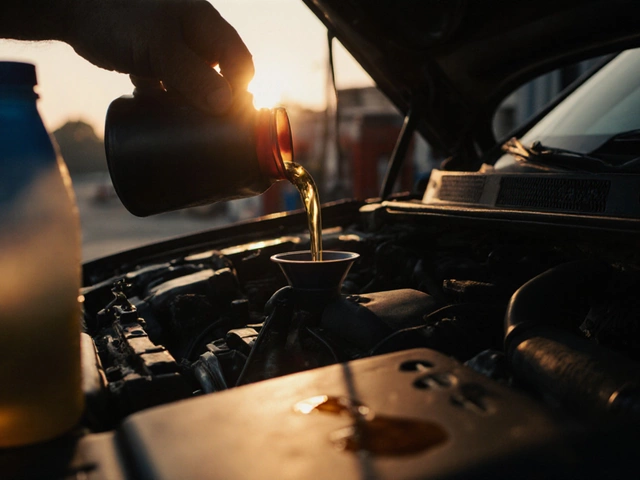Ever stand at the auto parts store staring at those racks of engine oils, feeling completely lost? I’ve been there. My hands get grubby, dog Rover is eyeing my boots, and I’m holding up the line, just trying to remember why some bottles say 5W30 and others have 10W30 painted across them in aggressive, bold font. If you’ve found yourself stuck in that same weird engine oil limbo, you’re not alone. Whether you wrench on your own car or trust your mechanic completely, oil choices can spook even the most seasoned drivers. But let’s see what actually matters instead of just memorizing letters and numbers.
What Do 5W30 and 10W30 Actually Mean?
Viscosity—now there’s a word that doesn’t roll easily off the tongue. It’s just a fancy way of talking about how "thick" or "runny" the oil is when it moves around your engine. Oil companies use this little code—like 5W30 or 10W30—to help you figure out what’s going on inside the bottle. Here’s how it breaks down:
The “W” stands for “winter.” The number before it (5 or 10) tells you how the oil acts when it’s cold outside. The lower the number, the thinner the oil is in low temperatures. 5W means it flows a bit easier in the freezing cold than 10W. Perfect if you start your car outside on January mornings.
The number at the end—30—tells you how thick the oil gets when it’s hot (think: regular driving temperature). Both 5W30 and 10W30 get the same thickness after the engine warms up. So, if you drive through snow or heat, both protect your engine when it’s at operating temperature.
Ever seen your oil look goopy on a cold morning? That’s why the first number matters. If your car struggles to start, or if you hear nasty knocking when you turn the key, thinner oil like 5W is your hero. If you live where winter is basically a rumor and your summer days boil the sidewalk, 10W isn’t a bad pick.
This isn’t just manufacturer mumbo-jumbo. SAE (Society of Automotive Engineers) sets the rules for these rankings. Their test: how fast oil flows at low and high temperatures. The right oil means less engine wear, smoother starts, and fewer grumpy noises on winter days. A study by the American Petroleum Institute showed engines using the recommended oil grade lasted 2-3 years longer before showing major wear, compared to “whatever was on sale.”
When Does 5W30 Shine? Pros and Cons
If you live anywhere with real winters, 5W30 is usually the home-run choice. It pumps smoothly at freezing temps, keeping all those tiny engine parts coated right from the first crank. And believe me, once you wake up a dozen mornings in a row scraping frost off your windshield, you start paying attention to what helps your car survive cold weather.
What’s neat is that 5W30 works for way more than just the harshest blizzards. Most carmakers, especially if your vehicle was built after 2000, actually recommend 5W30, even for “normal” climates. Why? Because thinner oil saves a little on fuel (less friction) and keeps newer engines running efficiently. That small edge can add up: AAA’s auto research division found engines using 5W30 improved mileage by around 2% compared to 10W30 in the same cars during city driving. That might sound tiny, but over a year, you’ll notice it at the pump.
But there’s a catch. Because it’s thinner, 5W30 isn’t always the best for old or high-mileage engines that are already a bit worn down. If your ride leaks oil, you may see it drip a little more with this grade. Sometimes older engines—even if they’re technically rated for 5W30—run quieter on something just a touch thicker.
Another fun fact: some performance cars (think turbocharged or sports engines) love 5W30 for those same cold-start reasons, because thin oil gets everywhere ultra-fast. But, if you’re always hauling or running the engine hot, talk to your mechanic. Some high-performance shops swap to thicker stuff, especially if you’re burning oil on long road trips.
All in all, if your owner’s manual says 5W30 and you live where winter means real cold, that’s the safest bet. It’ll help that Check Engine Light stay blissfully dark. Here’s a quick reference:
| Oil Grade | Best for | Fuel efficiency | Cold-start Protection |
|---|---|---|---|
| 5W30 | Modern engines, cold/temperate climates | High | Excellent |
| 10W30 | Older engines, warm climates | Good | Moderate |

10W30: When to Use the Old Faithful
Let’s be fair—10W30 isn’t some fossil waiting to be forgotten. It still has a definite spot in the garage, especially if you live where snow appears on postcards and not your driveway. The main advantage? It’s a touch thicker on cold starts, but that means it’s sturdier once the engine gets really hot.
That extra thickness on startup was gold back in the days of looser engine machining tolerances (think cars before the 2000s). If you’re driving an older pickup, a heavily-used SUV, or maybe you inherited a ride that likes to guzzle oil, that extra bit of cushion from 10W can make engines sound and feel “right.”
If you put your car through tough jobs—towing, off-roading, lots of city traffic in brutal summer heat—10W30 sometimes gives a little more protection. The thicker oil film is less likely to get squeezed out of worn bearings, which is why a lot of backyard mechanics swear by it for engines with a few more birthdays. In fact, Consumer Reports did a test with several older vehicles: those given 10W30 during summer highway trips had lower oil consumption rates compared to 5W30 by about 8% over 5,000 miles.
But 10W30 does have a downside—cold starts are tougher. If temps regularly drop under 15°F in the winter, expect the engine to take longer to build oil pressure, which can lead to a little extra grinding noise and more wear over time. Most new engines aren’t built for this grade because manufacturing has gotten much more precise, making thinner oil safe even during hard running.
The bottom line? If you’ve got something older, it’s summer most of the year, or you drive long distances with heavy loads, 10W30 is a solid pick. Some folks even switch between 5W30 in winter and 10W30 once the weather heats up—a trick that older engine manuals sometimes recommended.
Making the Right Choice: Tips That Actually Help
Choosing between 5W30 and 10W30 isn’t about guessing or doing what the neighbor does. It’s all about what your car, your climate, and your lifestyle demand. Here’s what actually helps you decide:
- Check your owner’s manual – This one is obvious, but it works. Carmakers test engines under crazy conditions, so the recommended oil usually fits best.
- Pay attention to leaks and engine age – If you’ve got a newer car (post-2000), or you don’t lose oil between changes, 5W30 is probably your best friend. Leaky or tired engines might quiet down with 10W30.
- Think about your local climate – Regularly see lows below freezing? Go 5W30 for better protection. If winters are mild and summers sizzle, 10W30 can be a smart call.
- Watch your dashboard – If your oil light flickers, you hear funny noises, or oil usage goes wild after switching grades, trust your gut (and your mechanic’s advice).
- Don’t mix grades for fun – Topping off with a different oil once in a pinch won’t destroy your engine, but it’s no long-term strategy.
- Buy quality oil – Not all brands are equal. Look for API or ACEA ratings on the bottle. Cheap oil can leave sludge and won’t last as long—false savings that cost way more down the road.
- If you drive extreme—heavy towing, racing, or just love redline RPMs—talk to a shop that knows your car. Some specialty engines truly need unique oil.
Remember that engine design and local weather are changing, too. For example, hybrids and turbocharged cars often demand thinner oils. Electric cars? No oil needed at all—but let’s not get ahead of ourselves. The point is: today’s best oil might not be tomorrow’s, so check every time you shop. Even carmakers tweak their recommendations based on updated testing or new regulations.
If you’re ever torn, use the "oil cap test"—whatever viscosity is printed right on your oil cap is what the manufacturer thinks is safest for most owners. Or, next time you’re buying oil, flag down the most grease-covered guy at the counter. Usually, he’s got a story (and a solid opinion) about which oil he runs.
To wrap it up—neither 5W30 nor 10W30 is “better” in every single case. Stick with the manufacturer’s call unless your engine’s needs have clearly changed. And don’t skimp on quality—good oil, changed on time, keeps your ride smoother, longer, and less likely to drop surprises on the highway. Your wallet, your mechanic, and maybe even your dog will thank you.


